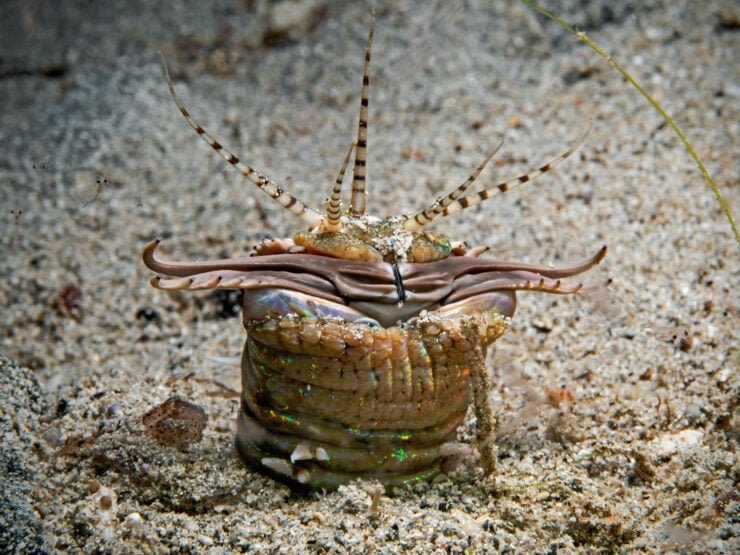
You might be wondering why we’re talking about the Bobbit worm and its documented attacks on large fish. Well, as strange as it sounds, these incidents provide valuable insight into the complex and often brutal dynamics of marine life. By understanding how the Bobbit worm operates, we can learn more about the underwater ecosystem. So let’s dive deeper into the world of these intriguing creatures and their dramatic encounters with larger fish.
What Exactly is a Bobbit Worm?
The Bobbit worm, scientifically known as *Eunice aphroditois*, is a marine polychaete worm that lives in warm-water oceans. These worms can grow impressively long, up to 10 feet or more, and they have a body covered in vibrant bristles. It’s a sight to see! But don’t let their beautiful appearance fool you; they are lethal hunters. The worm’s body is segmented, which allows it to move quickly and strike with precision.
These worms are mostly found buried in sandy or muddy bottoms, often in coral reef habitats where they can blend in seamlessly with their surroundings. Their unique adaptations let them go unnoticed until it’s too late for their prey. When a fish or any unfortunate creature comes too close, the Bobbit worm slithers out with lightning speed, using its sharp jaws to snatch the prey. It’s almost like a magician’s trick, where the audience doesn’t see the secret until the moment of revelation!
Bobbit Worm Anatomy: The Perfect Predator
To understand how the Bobbit worm is so effective at hunting, let’s break down its anatomy. The structure of this creature is a masterpiece of evolution. One of its most notable features is its powerful jaws. These aren’t your average, garden-variety jaws; they are strong enough to bite through fish and other sizable prey.
Another significant feature is its long, flexible body, which not only helps it move swiftly but also allows it to camouflage itself within the ocean floor. The bristles along its body aid in diving and gripping onto surfaces, while also helping it sense vibrations in the water. This sensory ability is crucial for detecting movements around it, allowing the worm to anticipate attacks before they happen.
The combination of sharp jaws, stealthy movement, and camouflage makes the Bobbit worm a highly effective predator. Imagine being on the receiving end of such a well-crafted machine—it’s no wonder that documented attacks on large fish have captivated the attention of marine biologists!
Documented Attacks: The Evidence
Now that we’ve covered the worm’s anatomy, let’s talk about the documented attacks themselves. It’s not just sensational stories; these encounters have been observed and recorded in various marine studies. Research has shown that Bobbit worms can take down prey much larger than themselves, including fish that typically inhabit coral reefs.
In one instance, a large grouper was found to have been attacked by a Bobbit worm. The fish had sustained significant injuries, clearly showcasing the worm’s lethal hunting techniques. Such incidents have been recorded across various species, highlighting the Bobbit worm’s position in the marine food chain. They are not just accidental attacks; these events show a stark glimpse into the ecosystem’s balance, where predators and prey intersect.
Researchers have witnessed the initial ambush, where the Bobbit worm strikes suddenly, often catching its target off guard. The manner in which it constricts and subdues its prey is both awe-inspiring and terrifying. The speed and effectiveness of these attacks shed light on the importance of understanding this creature—after all, it’s a pivotal player in marine ecosystems.
The Impact of Bobbit Worm Attacks on Fish Populations
So, what does it all mean for fish populations? The Bobbit worm’s presence and attacks can have far-reaching implications for local ecosystems. When these worms hunt successfully, they impact the population dynamics of various fish species. This can lead to changes in behaviors, feeding patterns, and even the overall biodiversity of the area.
For instance, if large predatory fish like groupers fall victim to Bobbit worms, it may create an imbalance, allowing smaller fish species to thrive unchecked. This ripple effect showcases the interconnectedness of marine life. It also raises questions about how the presence of Bobbit worms might influence conservation strategies for both fish populations and their habitats.
Comparing Bobbit Worms to Other Marine Predators
While the Bobbit worm is fascinating, it’s not the only predator in the ocean. When comparing it to other marine hunters, like sharks or barracudas, the Bobbit worm’s tactics are quite different. Sharks, for instance, rely on speed and strength, while the Bobbit worm uses patience and stealth.
Here’s a quick comparison:
- Sharks: Fast, powerful swimmers that hunt larger fish.
- Barracudas: Known for their speed and sharp teeth, they strike quickly.
- Bobbit Worms: Masters of ambush, they wait silently before making their move.
Each of these predators plays a unique role in the ecosystem, and understanding their differences helps reveal how marine life functions as a whole. While sharks and barracudas tend to dominate the upper levels of the food chain, the Bobbit worm operates from below, influencing the environment in its own way.
The world of the Bobbit worm is one that is full of surprises and stark reality. These fascinating creatures, with their stealthy hunting methods, play a crucial role in marine ecosystems. Documented attacks on large fish remind us of the delicate balance between predator and prey in the ocean.
Understanding the Bobbit worm’s impact helps us see the bigger picture in marine biology. As we continue to explore the depths of the ocean, who knows what other secrets await us? Keep this intriguing worm in mind the next time you think about marine life; after all, it’s not just about the big and flashy. Sometimes, the most impactful creatures are those that hide in the shadows.

